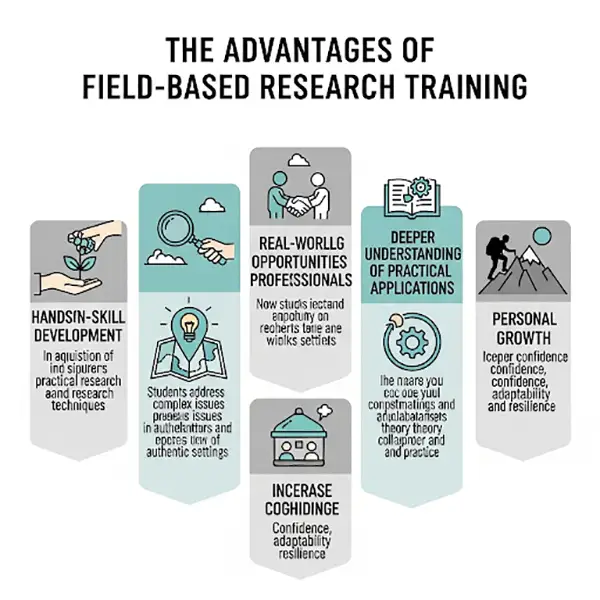
Studies show that students who participate in research have better knowledge about how to carry out Research and better skills in analyzing data [Source: Council on Undergraduate Research]
Field research takes a step beyond by emerging in work, whether that means excavating a historical site or checking an endangered ecosystem. It is the context for theories to exist; it is the location for developing original data for discovery.
There is more field work than just packing for a research trip; it is not like finding a cheap essay writer. A successful field work includes extensive planning and preparation before packing your backpack. Thereby, field research students will learn what to pack and how to prepare properly.
Read this guide from beginning to the end!
KEY TAKEAWAYS
- Tough preparation is important to deal with critical situations.
- Pack every necessary item in your bag.
- Develop a consistent system for taking notes, labeling samples and naming digital files.
- Be respectful and flexible to the local culture and environment.
Before You Go: Mental and Logistical Prep
The real preparation starts from your desk. Research the region first. Check the climate and seasonality, local customs, the political context, and any environmental hazards. Utilize this information to set your packing list and guide how you operate once you arrive.
Start with assembling important documents like passports, any visas, research permits, proof of travel insurance, and a fresh emergency contact list. Get its duplicates and upload scans to a secure cloud folder. Make sure to add a brief index so you can locate files fast. This may seem easy, but it prevents holdups and keeps you safer on the road.
Create a basic strategy for each day. Outline travel legs, tasks, and contact points and keep in mind to add buffer time for late transport or bad weather. Send a copy to your advisor and your check-in contact at home. Keep it adaptable so you can shift as soon as conditions change.
Packing Your Gear: Function First
Be mindful of your packing. Every item should be placed according to the need. You may change your list by discipline, but most bags include three groups: research tools, documentation gear, and personal kit.
Build your field kit around the work purpose. First, collect the tools that fit your research methods. Second, set up reliable documentation gear with a waterproof notebook, tough pens, a rugged camera with spare batteries, and an audio recorder if the project calls for it. At the end, pack the personal essentials that protect comfort and safety. These sun and rain protection, include quick-dry layers, and sturdy, broken-in boots suited to the terrain.
Essential Categories of Field Research Tools
- Data collection instruments: Soil kits, calipers, binoculars, survey sets, geological hammers, or interview recorders matched to your method.
- Navigation tools: A traditional compass, a reliable GPS, and paper topographic maps for no-power backup.
- Sampling and storage: Sterile containers, sample bags, vials, labels, plant presses, and tamper-resistant seals where required.
- Power and charging: A large power bank, backup charger, or a foldable solar and the right plug adapters for the country
- Safety equipment: A personal locator beacon, a water filter or purifier, or satellite phone, and a medical kit suited to local risks.
INTERESTING FACT
STUDENTS ARE MORE FASCINATED ABOUT FIELD-BASED TRAINING THAN THEORETICAL TRAINING.

The Craft of Solid Field Documentation
You should focus on your primary job, which is to get clean, usable data, including a system you can follow even when you are tired or rushed. Before leaving, decide on a note format. In each entry, record the GPS coordinates, date, time, weather, site conditions, and observations alongside the raw data. Always write clear, consistent symbols, and keep abbreviations as quick sketches when they explain better than words.
Create a naming convention for files and samples. Include project code, site ID, date in ISO format, and version numbers. Every day, backup digital files to two locations: a rugged drive and the cloud when you find a connection. Keep notebooks in waterproof sleeves and use a pencil if there is a chance of rain. Label every sample the moment you collect it, not later at camp. Clean metadata now saves hours during analysis and writing, whether you draft alone or enlist the help of an essay writing service, such as EssayService, for final polish.
Plan your data flow. Decide how raw notes become structured tables, how photos link to entries, and when you log transfers. A simple checklist (collect, label, log, store, back up) reduces mistakes when conditions get hectic.
On-Site Etiquette and Real-World Flexibility
Treat the site as if it were someone’s home and workplace; you are a guest there. Learn how to say hello, be mindful of traditions, and ask before photographing people, homes, or sacred spaces. Share your goals clearly and listen first. Prioritize listening and effectively communicating your intentions. Strong relationships result in better access and better data.
Always anticipating plans to shift. Tools break. Weather changes fast. A site can close without notice. Learn how to say hello, be mindful of traditions, and seek permission before taking pictures of people, houses, or places of worship. Prioritize listening and effectively communicating your intentions. Observe local regulations and any permit requirements to save locations and ecosystems. Greater data and greater access are the results of strong partnerships.
Always assume that plans will change. Tools malfunction. The weather is subject to rapid change. A website may abruptly shut. Adaptability should be viewed as a fundamental skill. Keep a modest list of backup sites or techniques on hand, prioritize your duties, and carry tiny repair tools. If circumstances prevent you from completing your first plan, move on to a backup objective and gather as much information as you can. Rank tasks by priority, carry small repair items, and keep a short list of backup locations or methods. In case conditions stop your first plan, switch to a backup aim and collect the best data you can.
Timestamp shifts as they occur. Take note of the changes, the reasons for your adaptation, and the variations in approaches. This record guarantees that you report limitations honestly and defend your choices later.
In Closing: Ready for the Work
Preparation sets the floor for what you can learn. Pack with a clear purpose, document with discipline, and stay nimble when the field throws surprises at you. With that foundation, your time on site turns into meaningful results and real growth as a researcher. The field is a demanding teacher. Show up prepared and it will reward your effort.
What are the most essential items to pack for field research?
Reliable GPS, waterproof notebook, first-aid kit, and proper clothing for the climate and train are some essentials.
How can I keep my data safe in the field?
Carry a waterproof bag, and backup digital files daily in a cloud-based service whenever you have an Internet connection.
What safety precaution should I take?
Before reaching, research the potential hazards of the location, carry a comprehensive medical kit, and share your itinerary with your advisor and a contact at home.
How do I handle unexpected changes in the field?
Always be adaptable and have a backup plan, also carry basic repair items to deal with unexpected changes.









